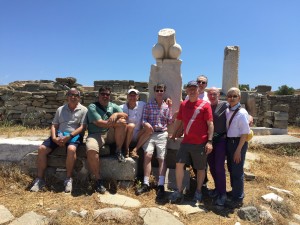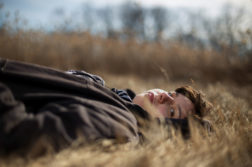
ABOUT HALFWAY THROUGH Andrew Lear’s wonderful, recently completed tour of “Gay Greece,” the guys on the trip started calling it the “Penis Tour” due to the large number of nude male statues that had passed before our eyes. As luck would have it, an article by Prof. Lear had just been published in which Andrew (a personal friend) addressed the widespread comment (complaint?) that statues of Greek men tend to present them with rather small penises. This being the case, perhaps it could best have been called the Small Penis Tour.
Of course, the trip was about much more than penises, and all of the places we visited—which included the major archaeological sites on anyone’s A List of ancient Greece—could be enjoyed by someone who wasn’t interested in men’s private parts at all. From Athens we traveled in a roughly clockwise direction down and across the Peloponnese, up to Delphi and around to a port east of Athens where we caught a ferry that brought us to Mykonos, where we stayed for two nights before sailing back to Athens. Along the way we visited the remains at Mycenae, the Bronze Age civilization that flourished 1,000 years before Athens’ Golden Age and gave us the Homeric epics; the vast ruins at Olympia, where the PanHellenic Games were held every four years for nearly a millennium; Delphi, site of the Oracle of Apollo and a well-preserved Greek theater; the island of Delos, birthplace of Apollo and Artemis, where great temples and colossal statues proliferate; and several other sites.
As someone who has been to Greece a number of times and actually lived on the island of Crete for five months in the late 1980s, I had visited most of these old sites before—which is not to say that they ever truly get old. But this time Andrew—a well-known Classical scholar and teacher—provided a level of historical background and aesthetic commentary that I’d never had in past visits (typically with my Let’s Go guide in hand). For example, in Olympia—the one major site I’d never visited before—Andrew was able to translate the ancient graffiti scratched into the walls of the athletes’ dressing (or undressing) rooms, in which athletes would comment on the physical beauty of their teammates.
At the vast site on the island of Delos, Andrew brought us to an area that’s always avoided by tour guides where a series of giant phalluses had been erected—pun intended, given the state of the phalluses in question. All have been lopped off somewhere close to the base, leaving only the testicles and an “angry inch” or two, but we can tell by their colossal scale that these were very large columns indeed. This would seem to fly against the principle of small penises—except, of course, these configurations are detached from any actual male body and thus become a kind of abstracted symbol of male power and the life-force. Also, not to be forgotten, these phallus statues were placed outside the temple of Dionysus.
The other major exception to the small penis rule, as Andrew pointed out, were Satyrs and old or disreputable figures whose very over-endowment was meant to symbolize their wantonness or low birth. That convention would fall under the rubric of what Nietzsche called the “Dionysian” spirit of dithyrambic madness and sexual excess. In contrast, small penises were associated with “Apollonian” refinement and nobility, the state of having one’s sexual and other passions under control. What’s more, they were typically attached to the bodies of athletes engaged in competitive sports—bodies of the highest excellence that immortalized an ideal of male beauty that still prevails today.
What’s even more outstanding than these physiques is the statues themselves (as well as the vase art), whose beauty and perfection have scarcely been surpassed in the thousands of years that have elapsed since their creation. This, of course, along with the other astonishing accomplishments of the Greek artists and architects, is the real reason why we go to Greece. A tour like Andrew’s can only remind us of the extravagance—the truly breathtaking magnitude—of the ancient Greeks’ achievement.
The trip was organized by Andrew Lear’s travel company, Oscar Wilde Tours. For information on upcoming trips, visit: www.oscarwildetours.com.
Richard Schneider Jr. is the editor of The Gay & Lesbian Review.






